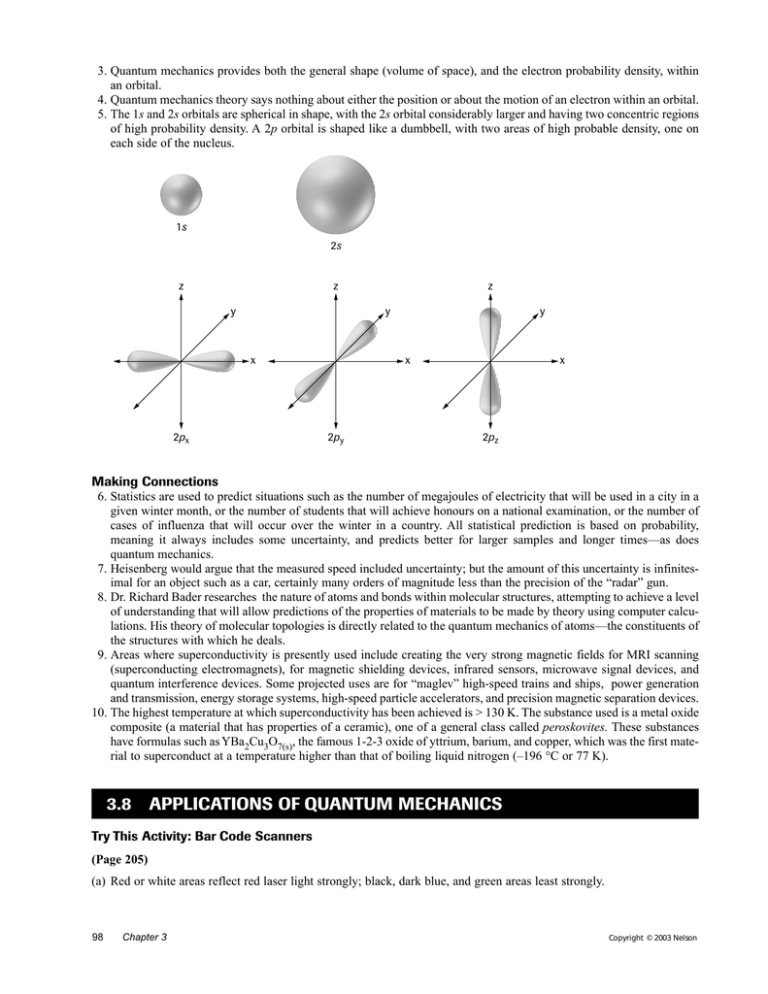Document 14458780
advertisement

3. Quantum mechanics provides both the general shape (volume of space), and the electron probability density, within an orbital. 4. Quantum mechanics theory says nothing about either the position or about the motion of an electron within an orbital. 5. The 1s and 2s orbitals are spherical in shape, with the 2s orbital considerably larger and having two concentric regions of high probability density. A 2p orbital is shaped like a dumbbell, with two areas of high probable density, one on each side of the nucleus. 1s 2s z z z y y y x 2p x x x 2p y 2p z Making Connections 6. Statistics are used to predict situations such as the number of megajoules of electricity that will be used in a city in a given winter month, or the number of students that will achieve honours on a national examination, or the number of cases of influenza that will occur over the winter in a country. All statistical prediction is based on probability, meaning it always includes some uncertainty, and predicts better for larger samples and longer times—as does quantum mechanics. 7. Heisenberg would argue that the measured speed included uncertainty; but the amount of this uncertainty is infinitesimal for an object such as a car, certainly many orders of magnitude less than the precision of the “radar” gun. 8. Dr. Richard Bader researches the nature of atoms and bonds within molecular structures, attempting to achieve a level of understanding that will allow predictions of the properties of materials to be made by theory using computer calculations. His theory of molecular topologies is directly related to the quantum mechanics of atoms—the constituents of the structures with which he deals. 9. Areas where superconductivity is presently used include creating the very strong magnetic fields for MRI scanning (superconducting electromagnets), for magnetic shielding devices, infrared sensors, microwave signal devices, and quantum interference devices. Some projected uses are for “maglev” high-speed trains and ships, power generation and transmission, energy storage systems, high-speed particle accelerators, and precision magnetic separation devices. 10. The highest temperature at which superconductivity has been achieved is > 130 K. The substance used is a metal oxide composite (a material that has properties of a ceramic), one of a general class called peroskovites. These substances have formulas such as YBa2Cu3O7(s), the famous 1-2-3 oxide of yttrium, barium, and copper, which was the first material to superconduct at a temperature higher than that of boiling liquid nitrogen (–196 °C or 77 K). 3.8 APPLICATIONS OF QUANTUM MECHANICS Try This Activity: Bar Code Scanners (Page 205) (a) Red or white areas reflect red laser light strongly; black, dark blue, and green areas least strongly. 98 Chapter 3 Copyright © 2003 Nelson (b) Bar code scanners read the bright-to-dark-to-bright light level changes, and how long they last (which depends on the code line width) as an information signal. SECTION 3.8 QUESTIONS (Page 206) Understanding Concepts 1. Laser light is monochromatic (one colour/wavelength/frequency), coherent (acts like one long continuous wave), and collimated (rays are quite precisely parallel). 2. Lasers work on a principle of raising many electrons to a higher energy level, and then stimulating them to drop to a lower level all at once, producing an output of a very large number of photons. 3. Applications of the principles of quantum mechanics in medical diagnosis include the use of infrared spectroscopes to detect traces of substances in body tissues and fluids; and the use of MRI machines to scan the inside of the body by causing tissues to emit microwave radiation. Making Connections 4. (Student reports will vary, but should include a basic description and diagrams of X-ray diffraction due to interference of the very short electromagnetic wavelengths with the similarly sized spacings between entities in solid crystals— which provides information about the sizes, shapes, charges, and arrangements of these entities in condensed phases. A simple parallel phenomenon is the diffraction pattern created when a pocket laser pointer beam is reflected from the surface of a CD. The angular displacement of the secondary images is proportional to the line spacing on the CD. Students with physics background in calculations of the diffraction of light from diffraction gratings can easily calculate the CD line spacing using the same technique.) CAREERS IN CHEMISTRY PRACTICE (Page 207) Making Connections 1. (A typical report would include information such as:) In the field of Biochemistry, a gene medicine scientist may do precise mass determinations of purified peptides, proteins, and oligosaccharides, using MALDI (Matrix Assisted Laser Desorption/Ionization time of flight) mass spectroscopic analysis. A scientist in charge of this area for a company would also prepare complex biological samples and determine atomic sequencing in organic molecules, in order to identify and develop new therapeutic materials. Such a position would require a Ph.D. in biochemistry or chemistry, preferably with a few years postdoctoral experience, or an M.Sc. in biochemistry with 10+ years of related experience. People in this area are in demand worldwide, and annual salaries on the order of $100 000 are not uncommon in industrial areas. CHAPTER 3 LAB ACTIVITIES INVESTIGATION 3.1.1 THE NATURE OF CATHODE RAYS (Page 209) Evidence/Analysis (a) Observations of a Cathode Ray and Laser Light Cathode ray Laser light Effect of bar magnet ray moves perpendicular to the long axis of bar magnet no effect Effect of charged plates ray moves toward positive plate and away from negative plate no effect Copyright © 2003 Nelson Atomic Theories 99



